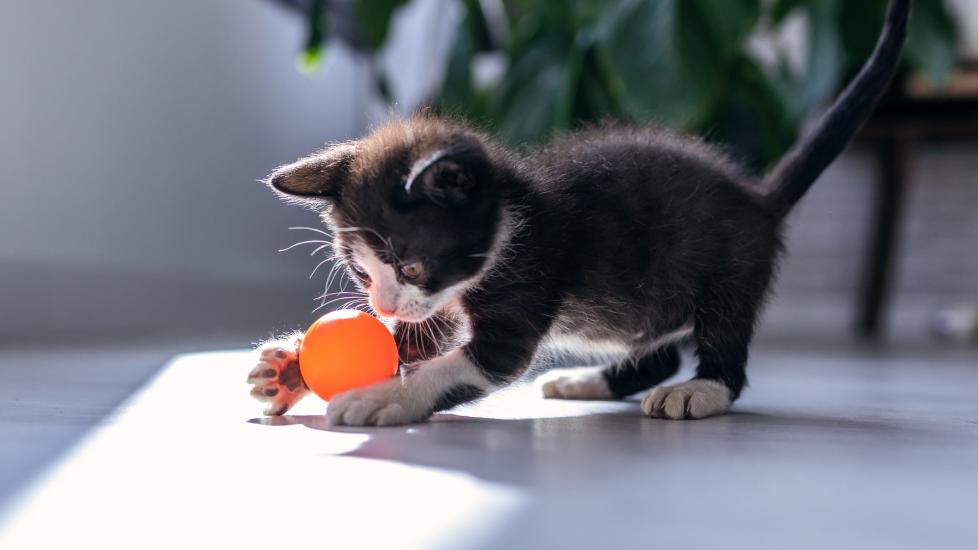How To Introduce a New Kitten to Your Home
Bringing a new kitty into your home is exciting—but it’s also a big commitment and must be planned out carefully. Pet parents must keep their kitten safe, comfortable, and happy in their new environment, and it can take a few days for a kitten to adjust.
Here’s how to introduce your kitten to your home and set them up for success.
1. Set up a Safe Space
The first step of kitten adoption happens before you bring home your new furry family member. Set up a safe, confined, and kitten-proofed area where they can stay when unsupervised. This will allow them to make a gradual transition into their new home and provides them their own safe space where they can relax. If you have other pets, this also lets your kitten and resident pets adjust to each other’s presence and prevents exposure to potential diseases.
The kitten-proofed area should be free of potentially hazardous, toxic, or valuable items, and you should also check for any nooks or crannies where a kitten might hide and become stuck. The space must also be easy to clean and easy to close off with a door. Preferred locations for a kitten are a spare bedroom, office, laundry room, or bathroom.
The room should have natural light, good airflow, be somewhat quiet, and prepared with everything a new kitten needs: a resting area, water and food bowls, several toys, and at least one or two litter boxes. Your kitten may also benefit from a Feliway® Calming Diffuser in the space.
2. Let the Kitten Explore
Immediately take the kitten to their designated room and let them explore the area at their own pace. It may take several days for a kitten to adjust to a new home—even a healthy and social kitten.
After your new kitten has had some quiet time in a restricted location, slowly allow access to other areas of the home under your supervision. Kittens are natural explorers, and during the first few weeks this gradual access to your home will meet their need for exploration.
If you have other pets, keep them in a separate area of the home while the kitten explores. This will allow your kitten to smell your resident pets (and for them to smell the kitten when they return) without the possibility for negative interactions. This process is called “scent swapping.”
3. Teach Your Kitten Proper Play
Multiple short, positive interactions during the day (about 10 minutes long each), as well as scheduled playtime, will strengthen the human-animal bond with your new family member. Play also provides your kitten with physical exercise and mental stimulation.
During these play sessions, it’s important to teach your kitten how to play properly and to work on eliminating play-related aggression, since a kitten’s idea of play may involve unsolicited scratching and biting. Lack of stimulation or a lack of appropriate play and exploratory behavior options can worsen this behavior.
Never punish a kitten for playing inappropriately. Instead, redirect any unwanted behavior toward one of three more appropriate activities:
-
Interactive play: The kitten plays on their own with treat-dispensing toys, interactive toys, boxes, iPad videos, etc.
-
Active play: The kitten plays with you, with help from wand toys, laser pointers, or feathered toys. Always use toys and never teach your kitten to play with your hands or feet.
-
Reward relaxation behaviors: Relaxing, petting, and grooming. Reward the kitten for calm and relaxed behavior.
4. Introduce the Kitten To Other Pets
Although some kittens may show fear and defensive postures toward other pets in the home, most young kittens are playful and inquisitive around other animals. It’s typically the existing pets that may pose more of a problem during introductions, so it’s important that intros are done slowly and properly.
Introducing the New Kitten to Your Cat
Keep the kitten and resident cat in separate rooms for the first seven to 14 days your new kitten is home. When introducing cats, let them briefly meet through a barrier, such as a baby gate. As long as both kitten and cat remain calm and relaxed, gradually increase these sessions and remove the barrier.
Remember that there is no set timeline for introductions—you should always progress at the rate your pets feel comfortable with.
Introducing the New Kitten to Your Dog
Keep the new kitten and your dog in separate rooms for the first seven to 14 days. Once both pets are comfortable sniffing each other through scent-swapping and hearing each other on opposite sides of the door, let them see each other.
For safety, use a barrier, such as a tall pet gate, when introducing a cat to your dog. If both pets remain calm and relaxed, make leashed introductions. Again: Go slow and at a pace both animals feel comfortable with.
5. Keep the Kitten Safe at Night
It’s preferred to keep kittens confined at night, even if they have access to other parts of the home during the day. Their initial “safe space” area can serve this need.
Because cats are crepuscular animals (meaning they’re active at dusk and dawn) and natural hunters, this practice can help prevent play-related behavior problems in the early morning or evening hours—and let you sleep undisturbed. It also helps keep your kitten safe, since they will be in a kitten-proofed area during these high-activity times.
Free video consult – ask our vet team anything about your new pet.
6. Consider Adopting Two Kittens
Simply put, it’s best to adopt two kittens instead of one. Adopting a pair of kittens gives them a built-in playmate as well as an outlet for mental stimulation and social development, according to the SPCA of Northern Virginia. It’s also more difficult to introduce two adult cats if you decide you want your resident cat to have a companion later.
Featured Image: Getty/nensuria
Help us make PetMD better
Was this article helpful?
